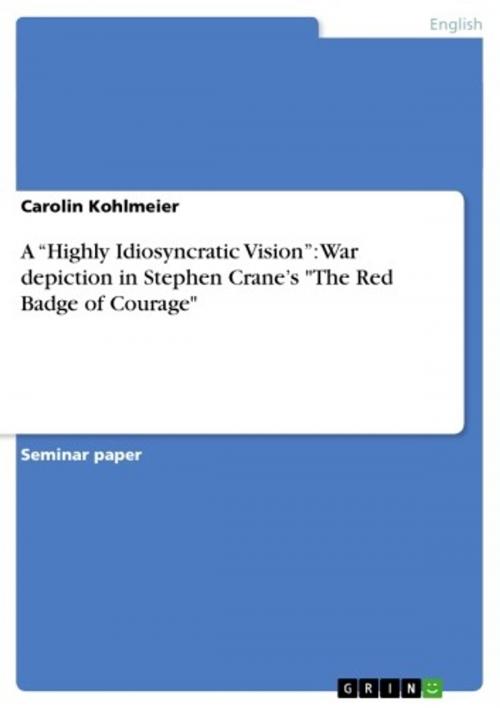A 'Highly Idiosyncratic Vision': War depiction in Stephen Crane's 'The Red Badge of Courage'
Nonfiction, Entertainment, Drama, Anthologies| Author: | Carolin Kohlmeier | ISBN: | 9783640162291 |
| Publisher: | GRIN Publishing | Publication: | September 11, 2008 |
| Imprint: | GRIN Publishing | Language: | English |
| Author: | Carolin Kohlmeier |
| ISBN: | 9783640162291 |
| Publisher: | GRIN Publishing |
| Publication: | September 11, 2008 |
| Imprint: | GRIN Publishing |
| Language: | English |
Seminar paper from the year 2005 in the subject American Studies - Literature, grade: 1,0, Bielefeld University, course: Realist and Naturalist Fiction, 17 entries in the bibliography, language: English, abstract: When Stephen Crane started to write his war book, which was to be named The Red Badge of Courage, in 1893 he was leading an impoverished existence in a former Art Students' League building in New York. His first novel Maggie, published at Crane's own expense, had brought him the respect of men of letters Hamlin Garland and W.D. Howells but in no way appealed to the reading public. The Red Badge, however, was acclaimed by critics and attracted the interest of the audience to such an extent that it became a success in both the United States and Great Britain. Probably the most astonishing fact about this 'first novel completely devoted to the experience of war' (Mitchell 13), until today praised as one of the finest pieces of American war fiction, is that it was written by a 21-year-old who had never experienced war himself but built entirely on his imagination and talent. However, the circumstances of its creation were by far not the only aspect which made this work of literature unique and pioneering- even though it took a long time for some of its other facets to be identified and understood. One of the most outstanding qualities of this novel remains that it polarizes and puzzles with respect to its form as well as to its content. A lot of Crane's early readers were captivated by its depiction of war experience, which was so uniquely vivid that 'one confused veteran was moved to claim that he had been with Crane in Antietam' (Benfey 107). Some critics were struck by Crane's genuinely new style, which they could hardly find terms to describe, whereas others made fun of Crane's Impressionist use of color (Weatherford 151 ff.). [...]
Seminar paper from the year 2005 in the subject American Studies - Literature, grade: 1,0, Bielefeld University, course: Realist and Naturalist Fiction, 17 entries in the bibliography, language: English, abstract: When Stephen Crane started to write his war book, which was to be named The Red Badge of Courage, in 1893 he was leading an impoverished existence in a former Art Students' League building in New York. His first novel Maggie, published at Crane's own expense, had brought him the respect of men of letters Hamlin Garland and W.D. Howells but in no way appealed to the reading public. The Red Badge, however, was acclaimed by critics and attracted the interest of the audience to such an extent that it became a success in both the United States and Great Britain. Probably the most astonishing fact about this 'first novel completely devoted to the experience of war' (Mitchell 13), until today praised as one of the finest pieces of American war fiction, is that it was written by a 21-year-old who had never experienced war himself but built entirely on his imagination and talent. However, the circumstances of its creation were by far not the only aspect which made this work of literature unique and pioneering- even though it took a long time for some of its other facets to be identified and understood. One of the most outstanding qualities of this novel remains that it polarizes and puzzles with respect to its form as well as to its content. A lot of Crane's early readers were captivated by its depiction of war experience, which was so uniquely vivid that 'one confused veteran was moved to claim that he had been with Crane in Antietam' (Benfey 107). Some critics were struck by Crane's genuinely new style, which they could hardly find terms to describe, whereas others made fun of Crane's Impressionist use of color (Weatherford 151 ff.). [...]















